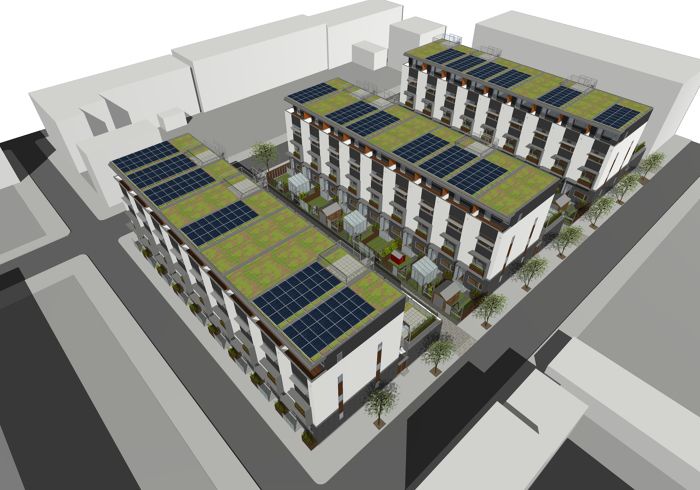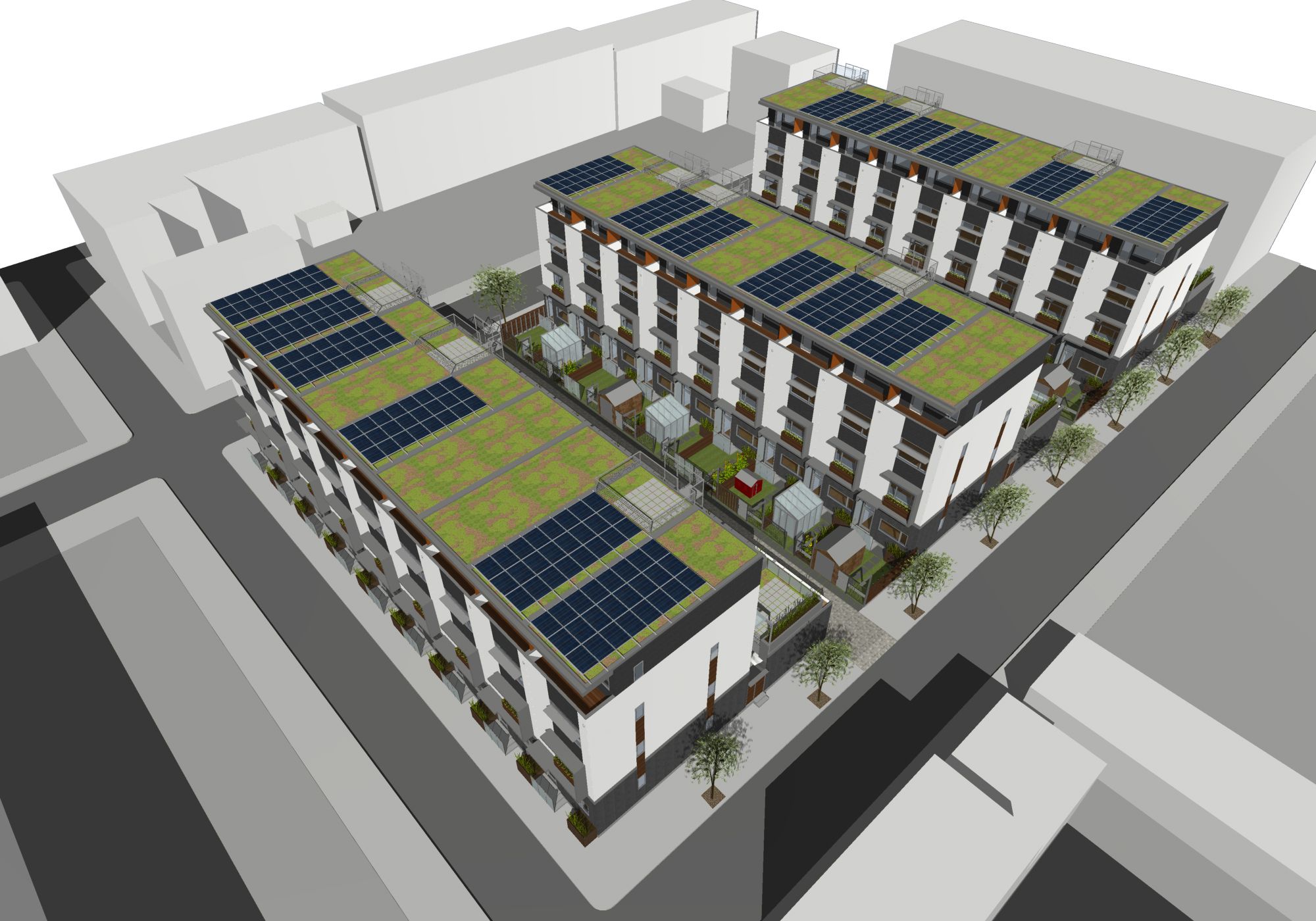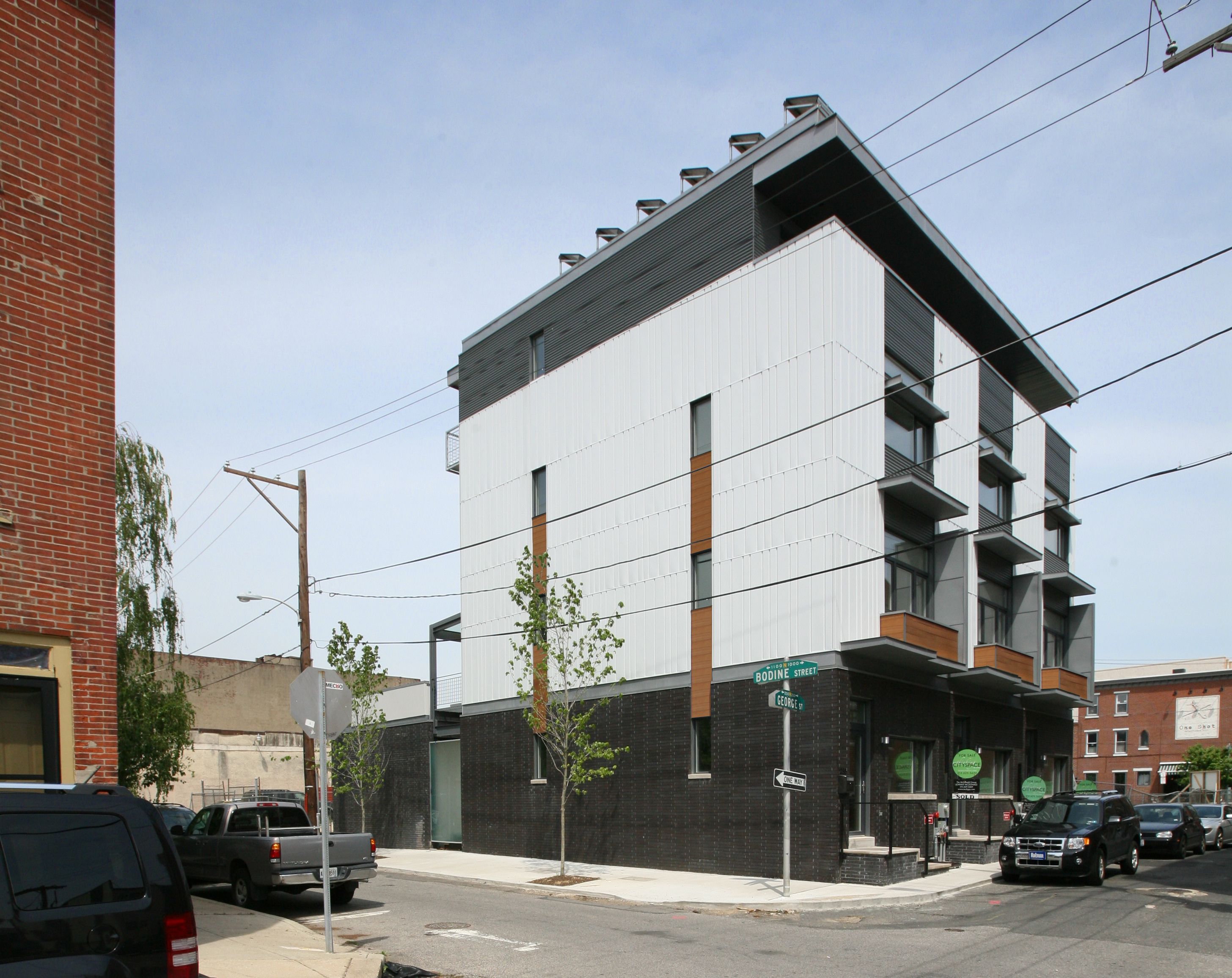
Onion Flats, a Philadelphia design-build firm that last year completed Pennsylvania’s first certified Passive House project, is transforming a one-time site of horse stables into a 27-unit town-house project built to the Passive House standard.
The Stables was originally planned as a 70-unit condominium project, but that was derailed by the collapse of the housing industry in 2008, says Onion Flats president Tim McDonald. By the time the financial picture had improved, the company had become more interested in Passive House design and had decided to rework the project. Its partner on the project is Domani Developers, also of Philadelphia.
The 2500-sq.-ft. town houses, located in the Northern Liberties neighborhood just north of the Old City, will be divided into three “bars” of nine units each, McDonald says. Three modular units have been completed, and two of those have been sold. When the third unit has been sold, work will continue on the remaining units in the first bar, with the whole project potentially wrapped up in another year.
According to McDonald, a blower-door test on one of the completed units meets the airtightness requirements in the Passive House standard. “Everybody is confident that it’s going to be certified,” he says, “but that’s a process that we have to go through.”
In order to win certification, a Passive House building must show no more than 0.6 air changes per hour at a pressure difference of 50 pascals, while also demonstrating (through energy-modeling software) that it is likely to meet an energy-consumption limit. Town houses also have the potential of meeting all of their own energy needs as net-zero-energy structures.
The town house currently on the market is listed at $749,000 by The McDonald Group.
Four levels, plus a finished basement
As described by a sales brochure for the project, each town house occupies a 16-ft. by 40-ft. footprint, not including a 26-ft.-long carport in the back.
The first level is designed as a flexible space that could be a media room, an office, a fourth bedroom, or what McDonald calls a “grandmother suite.” The combined kitchen/dining/living area and an exterior terrace take up the second floor, with two bedrooms, a bath, and a laundry on the third floor. The fourth floor includes the master bedroom and bath, a walk-in closet, and a balcony.
There are three full baths, with optional upgrades that would make the 640-sq.-ft. basement a finished living space and create a 170-sq.-ft. rooftop terrace.
McDonald says the modular units making up the town houses have 2×6 walls insulated with dense-packed cellulose and an additional 2 in. of XPS rigid foam on the exterior. The roof and floor also are insulated with a combination of cellulose and rigid foam, with total R-values of R-34 in the exterior walls and R-52 in the roof. The doors and triple-glazed windows are manufactured by Intus.
To meet city requirements for storm-water management, the vegetated roof is designed to absorb and reuse the first 1 in. of rainfall, McDonald says. Onion Flats has a division called GRASS (Green Roofs and Solar Systems) that designs the roof system, which the company uses on its projects whenever possible.
Town houses could be energy self-sufficient
Each town house is sold with a 4.23kw photovoltaic array, with the option of doubling capacity to 8.5kw. With only two of the project’s eventual 27 units occupied, there’s not much of a track record on energy consumption to date, but McDonald says early signs are encouraging.
Town houses are equipped with “heavy-duty” monitoring systems that measure temperature, humidity, CO2 levels, and electricity consumption. In one unit that’s been occupied for four months, energy consumption so far has been what’s appropriate for a Passive House design. “If they keep going the way they’ve been going, they’re really going to hit the mark,” McDonald says. “With that in mind, if they had an 8.5kw system, if they doubled the size [of the array], then it could be a net-zero building.”
Mechanical engineer Robert Benson designed the heating and cooling equipment, which McDonald says starts with a PTAC (packaged terminal air conditioner), a through-the-wall unit with the condenser and evaporator built into the same box. At The Stables, the units combine a heat pump with an energy-recovery ventilator, so each unit’s duct system provides both heating and cooling as well as ventilation.
“It’s a really, really cool system that was modeled off these products in Europe called magic boxes that we can’t quite get yet here in the States,” McDonald says. “They’re about the size of a refrigerator and they do heating, cooling, ventilation, and domestic hot water.” Benson managed to get three of those functions out of his own design. Domestic hot water comes from a heat-pump water heater.
This is Onion Flat’s second foray into Passive House construction. Its first was the three-unit Belfield town homes, which McDonald says was the first certified Passive House project in the state. It was finished in 2012 and is listed as a certified project by Germany’s Passivhaus Institut.
Fine Homebuilding Recommended Products
Fine Homebuilding receives a commission for items purchased through links on this site, including Amazon Associates and other affiliate advertising programs.

Handy Heat Gun

8067 All-Weather Flashing Tape

Affordable IR Camera





























